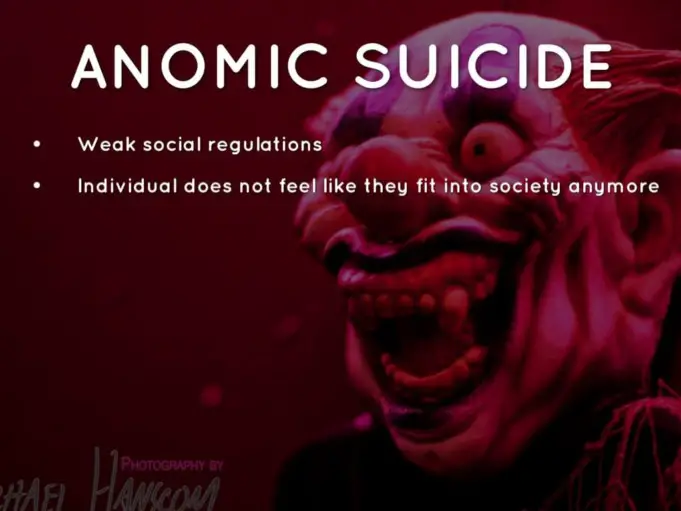In a family where kids are allowed to make decisions for themselves even before they become teenagers, there is bound to be disrespect, confusion, and chaos. Parents set rules and regulations in their homes to achieve a state of orderliness and to teach their kids good manners that will Help them in becoming better people in the society.
In the absence of any form of control over the behaviors of children by a parent, children behave in a confused fashion void of purpose and ability to decide what purpose means.
The same way a parent sets standard to help control his/her children so does the society set rules and regulations or policies to draw the line between socially acceptable behaviors and activities that may result in social instability and chaos. This way members of the society have rules as standards for living their lives.
The history of attempts to understand and explain suicide can be traced to the French sociologist David Èmile Durkheim. We have talked about the other kinds of suicide in previous articles but let’s take a brief recap to give fresh readers an idea of what we are dealing with.
Èmile Durkheim described four distinct types of suicide and identified two factors that influence them; the coefficients are social relationships and social regulations.
Both of the Suicide influencing factors (social rules and social integration) have dual characters in which they manifest their influence on suicide in the society in a “word and opposite” fashion. That is, “an excess” and “a lack.”
A lack of social integration in society could cause people to feel out of place and nurse suicide ideation thereby seeking an escape through death in the form of egoistic suicide. The opposite of a lack of excess social integration, being an excess of social integration could lead to self-annihilation called altruistic Suicide.
Similarly, the presence of severe social regulations or strict laws and policies could lead to frustration and hopelessness that eventually leads to Fatalistic Suicide. This leaves us with Anomic Suicide.
Anomic suicide is one of the Suicidal forms discussed by Èmile Durkheim that is the opposite of Fatalistic Suicide. To understand Anomic Suicide, we must first have an idea of what anomie is.
What is anomie?
Anomie is a sociological theory first mentioned by Èmile Durkheim in the year 1893 that has been understood as the state of lawlessness and absence of values and social norms. A breakdown of law and order in a society leading to possible alienation and a break of social bond between people and their culture.
However, Èmile Durkheim explained it as a mismatch between groups or personal standards and social standards of regulation (not necessarily an absence of laws or rules) and went further to connect anomic suicide with disappointment and disillusionment.
Anomic Suicide can happen when an individual has set unrealistic goals that make him or her seem over ambitious and then experiences a failure in achieving those goals as a result of a disagreement between the mediums deployed to achieve the desired effect and what is socially obtainable as defined by societal conditions.
Both natural and human-made factors can cause the mismatch between the mediums of attaining goals and societal regulations. People whose environments have experienced a natural disaster, or an economic crash are likely to consider an anomic Suicide.
Studies have shown a correlation between unemployment rate and anomic Suicide in the history of the United States of America between the year 1928 and 1932 when the price of unemployment almost hit 24 percent and was followed by a rise in Suicide rate. Also, in the year 2000 when the rate of unemployment was at about 4 percent, less Suicide report was recorded.
When people realize that a sudden change in their environment could be that their lives will never be the same, fright is inevitable. Victims of natural disasters often experience difficulties in recovering from their loss of property and environmental change thus they find themselves in a state of confusion with no guidance as to how to adapt to the changes or possibly get back on track with their previous life activities.
After that 1995 earthquake in Kobe, the Japanese public health department reported rising Suicide rates. Paint a mental picture of a person who happened to be the sole survivor of a boat wreck and got stuck in a lonely island with zero knowledge about the location of where he has found himself.
He tries to search for possible human settlements within the island so he can get help with finding his way home but soon realized he was the only person on the island but there was another island in sight though obviously far away from is located.
He then becomes confused and frustrated as it dawns on him that getting any form of help from the outside world might be impossible if he doesn’t try to reach out through signals that can be easily detected by passing boats or aircraft.
Because this character of ours has never been in such a situation before, he finds it difficult to make a signal using the available resources on the island despite knowing the possibility to make a fire from sticks and rocks to send a smoke signal.
He becomes burdened about his inability to figure a way to manipulate these signal tools because he has no guidelines on the steps to take. He was not also sure if he was going enough to find help or if he was going to send the right signal even if he figured how to, so he took his own life by drowning himself.
His uncertainty about what to expect from his situation and the mismatch between his desire to get help and what was obtainable on the island is responsible for his anomic suicide. Confusion characterizes the life of a person considering anomic suicide as to what defines doing enough, being enough, or having enough.
Suicide remains a deviant behavior and an issue of great concern. With recent reports of people committing suicide after posting a series of depressing messages on social media, it is our collective responsibility to look out for pointers in possible suicide risks in the lives of people but on our virtual spaces and around us.












